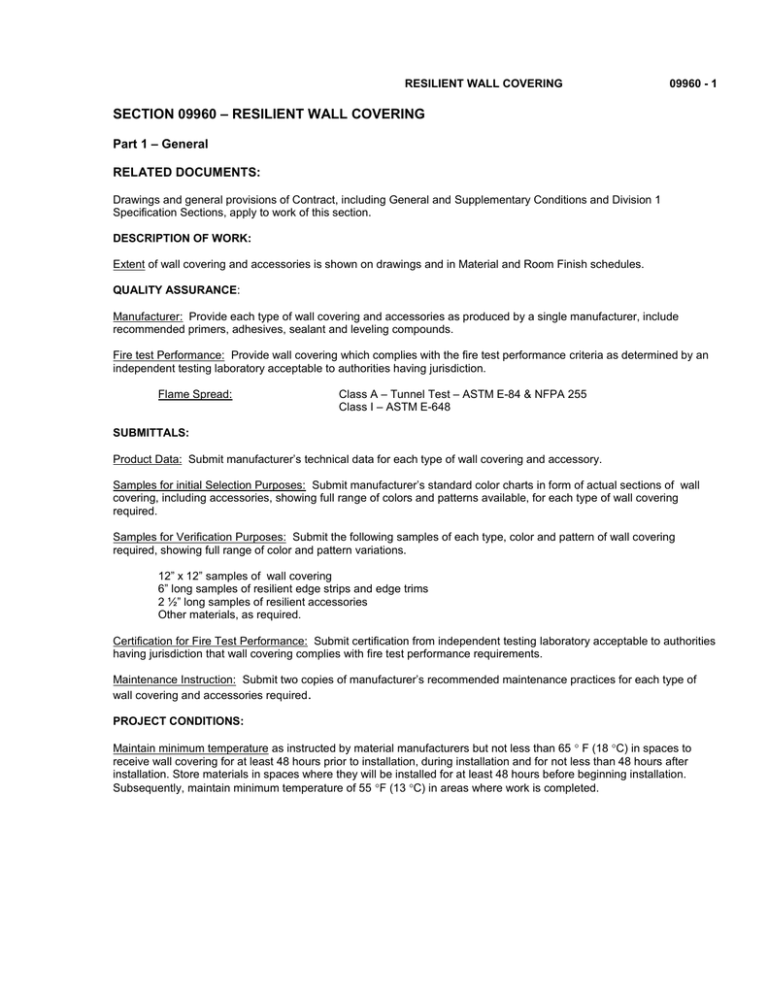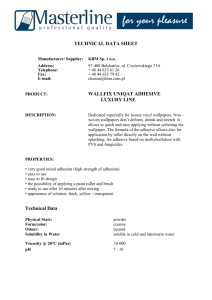resilient wall covering
advertisement

RESILIENT WALL COVERING 09960 - 1 SECTION 09960 – RESILIENT WALL COVERING Part 1 – General RELATED DOCUMENTS: Drawings and general provisions of Contract, including General and Supplementary Conditions and Division 1 Specification Sections, apply to work of this section. DESCRIPTION OF WORK: Extent of wall covering and accessories is shown on drawings and in Material and Room Finish schedules. QUALITY ASSURANCE: Manufacturer: Provide each type of wall covering and accessories as produced by a single manufacturer, include recommended primers, adhesives, sealant and leveling compounds. Fire test Performance: Provide wall covering which complies with the fire test performance criteria as determined by an independent testing laboratory acceptable to authorities having jurisdiction. Flame Spread: Class A – Tunnel Test – ASTM E-84 & NFPA 255 Class I – ASTM E-648 SUBMITTALS: Product Data: Submit manufacturer’s technical data for each type of wall covering and accessory. Samples for initial Selection Purposes: Submit manufacturer’s standard color charts in form of actual sections of wall covering, including accessories, showing full range of colors and patterns available, for each type of wall covering required. Samples for Verification Purposes: Submit the following samples of each type, color and pattern of wall covering required, showing full range of color and pattern variations. 12” x 12” samples of wall covering 6” long samples of resilient edge strips and edge trims 2 ½” long samples of resilient accessories Other materials, as required. Certification for Fire Test Performance: Submit certification from independent testing laboratory acceptable to authorities having jurisdiction that wall covering complies with fire test performance requirements. Maintenance Instruction: Submit two copies of manufacturer’s recommended maintenance practices for each type of wall covering and accessories required. PROJECT CONDITIONS: Maintain minimum temperature as instructed by material manufacturers but not less than 65 F (18 C) in spaces to receive wall covering for at least 48 hours prior to installation, during installation and for not less than 48 hours after installation. Store materials in spaces where they will be installed for at least 48 hours before beginning installation. Subsequently, maintain minimum temperature of 55 F (13 C) in areas where work is completed. RESILIENT WALL COVERING 09960-2 PART 2 – PRODUCTS MANUFACTURER: POLYFLOR LTD. (a Halstead Flooring Co.) P.O. Box 3, Radcliffe New Road Whitefield, Manchester, M45 7NR, U.K. DISTRIBUTOR: GERBERT LTD. 715 Fountain Avenue, P O Box 4944 Lancaster, PA 17604-4944 Phone 1-888-359-5466 - 717-299-5035 Fax 1-717-394-1937 Email: gerbertinfo@gerbertltd.com Products are available through contract flooring dealers. RESILIENT WALL COVERING COLORS AND PATTERNS: Provide color and patterns as indicated, or if not indicated in Materials Schedule and/or drawings as selected by Architect from manufacturer’s standards. VINYL SHEET WALL COVERING: High vinyl content, mono-layered construction and non-directional design. High vinyl content without backing: Provide nonlayered vinyl wall covering sheet with color extending through its full thickness and complying with the following requirements: Standards: ASTM E662 Class A Thickness: Polyclad Polyclad Plus 1.25mm (nominal 0.050”) 2.0mm (nominal 0.080”) Sheet Dimension: Polyclad Polyclad Plus 1.83M x 30M (nominal 6’ x 98.4’) 2 M x 20 M (nominal 6 ft. 6 in x 66 ft) Welding Thread: Vinyl thread or rod as produced by the manufacturer of wall covering and intended for heat sealing of joints. Color to match field of wall covering unless otherwise noted. Polyclad and/or Polyclad Plus Flame Spread & Smoke Emission Light Fastness Chemical Resistance Clean Rooms Resistance to Biological Attack Thickness Offered ASTM E648 Class A 7 Good Resistance to dilute acids and alkalis Class 10 Fed Std 201-D Class M 2.5 Fed Std 201-E Will not support bacteria and micro-organisms. 1.25mm & 2.0mm (nominal 0.050” and 0.080”) RESILIENT WALL COVERING 09960-3 ACCESSORIES: Adhesive: Use only manufacturer’s approved adhesive. Adhesive available through dealers or Gerbert Ltd. Submit list of manufacturer approved adhesives to Architect for approval. PART 3 – EXECUTION INSPECTION: Require installer to inspect wall surfaces to determine that they are satisfactory. A satisfactory wall surface is defined as one that is smooth and free from cracks, holes, ridges, or coatings preventing adhesive bond and other defects impairing performance or appearance. SITE CONDITIONS AND INITIAL PREPARATION: Ensure there is suitable working temperature of at least 18C (65F). Condition both the vinyl wall covering and the adhesive for at least 24 hours. Ensure walls and ceilings are dry, clean and free from contamination. Lumps, etc should be removed by scraping or sanding and hollows filled with a suitable filler. It is essential that all surfaces should be primed before fixing the cove formers with a suitable primer or other primer recommended by the adhesive manufacturer. NOTE: Failure to prime all surfaces beforehand will result in installation problems. PREPARATION: Do not allow resilient wall work to proceed until wall surfaces are satisfactory. The wall surface must be smooth, sound, clean and dry. All paint, oil, grease, excessive dust and any other contaminants liable to impair a primer compatible with the adhesive in use. Plaster and Plasterboard are ideal substrates. Prepare sub-floor surface as follows: Use cementitious leveling and patching compounds as recommended by resilient wall manufacturer for filling small cracks, holes and depressions and leveling walls. The general contractor shall be responsible for leveling new or existing walls. Notify Owner, Architect and General Contractor in writing where substrate is not level, where there are surface imperfections or where the wall is not plumb before proceeding with the work. Gypsum based leveling compounds will not be accepted. Remove coatings from wall surfaces that would prevent adhesive bond, including curing compounds incompatible with resilient wall adhesives, paints, oils, waxes and sealers. INSTALLATION: INSTALLATION, GENERAL: Installer verification: All Polyflor materials should be installed by a professional mechanic, preferably one who has attended an installation clinic or a Master Mechanic Training Seminar. Field verification: Field verify, prior to installation, exact layout dimensions of all seams, patterns, grain directions and insets with Architect. Start of work without Architect approval of field verification is not permitted and unauthorized installations shall be replaced at Contractors expense. Install wall covering using method indicated in strict compliance with manufacturer’s printed instructions. Scribe, cut and fit wall covering permanent fixtures built in ceilings and walls, pipes, outlets and permanent columns, walls and partitions. RESILIENT WALL COVERING 09960 – 4 Maintain reference markers, holes or openings that are in place or plainly marked for future cutting by repeating on finish wall as marked on substrate. Use chalk or other non-permanent marking device. Install wall covering on covers for telephone and electrical ducts, and other such items as occur within finished wall areas. Maintain overall continuity of color and pattern with pieces of wall covering installed on these covers. Tightly cement edges to perimeter of wall around covers and to covers. Tightly adhere wall covering to substrate without open cracks, voids, raising and puckering at joints, telegraphing of adhesive spreader marks or other surface imperfections. Hand roll wall covering at perimeter of each covered area to assure adhesion. CEILINGS AND WALLS, COVE FORMER: Snap a chalk line on the ceiling 250mm (10”) from and parallel to the longest wall and repeat for remaining walls. At right angles to the direction of installing the vinyl sheet, fix Upti-Tape to the inside of the chalk line leaving 250mm (10”) between the tape and the wall. Repeat at opposite end of ceiling. Fit and fix the cove former to internal corners and at the junction of the ceiling and top of the wall. Use 25mm (1”) wide Opti Tape on the two back edges of the cove former and press on firmly. First fit the miters in the corners and at the junction of the ceiling and top of the wall. For ease of use, short lengths of approximately 300mm (12”) are recommended. When all corners are completed, fit and fix the longer straight lengths using the same method. When all the cove former is fixed, apply the Opti Tape to the center of the face of all the cove former, leaving the top protective paper on at this stage. Using a lamb’s wool roller, apply Gerbert 2525 adhesive to the previously primed surface, slightly overlapping the Opti Tape, then trowel the adhesive using a correctly notched trowel. Initially apply the adhesive approximately 2 meters x 2 meters (6.5’ x 6.5’) to allow time for getting the vinyl into position. NOTE: Using the lamb’s wool roller to apply the adhesive prevents it from dropping to the floor. A correctly notched trowel as recommended by the adhesive manufacturers, must be used subsequently to ensure an even coverage and a good adhesion bond. INSTALLATION OF SHEET WALL COVERING: It is advisable to fit both internal and external angles before fixing the main lengths. Cut material into 456mm (18”) wide strips and of sufficient length to allow an overlap where it abuts the material fixed to the ceiling. Drop a plumb line to one side of the angle to be framed 250mm(10”) from its center point. Loosely fit the 456mm (18”) wide strips to the plumb line and push into position so that the angle is formed, then cut and miter at the junction of the wall and ceiling. Apply Gerbert 2525 adhesive as previously described to correspond with the 456mm (18”) wide piece to be fixed, again ensuring the adhesive slightly overlaps the Opti tape. Remove the top layer of the Opti Tape and fit the precut piece into position against the plumb line and trimmed to the lines as necessary. This must be done while the adhesive is still tacky. Install all interior and exterior corners first. Full widths should be fixed in the following manner: Fix Opti tape around all outside edges of vinyl fixed on ceiling, leaving top layer on. Apply adhesive as before to wall and ceiling band slightly overlapping the Opti Tape. Position the vinyl over the edge of the corner piece fitted previously, ensuring that the overlap is equal (approximately 12mm (0.50”) over) from the floor up. Roll the material into the adhesive working from the bottom upwards. Cut at the top, allowing sufficient to overlap the vinyl on the ceiling. Remove the top layer of the Opti Tape from the face of both the cove formers at the junction of wall and ceiling. Press the vinyl into the cove radius and to the ceiling band. Trim off any excess material, ensuring a tight joint is obtained. Subsequent lengths should be fitted in the same manner. All joints should be heat welded on completion, allowing at least 24 hours after fitting for sufficient moisture to dry out of the adhesive. Finally, trim welds when cold to prevent sunken welds. Prime the areas of plastered wall with a suitable adhesive/primer such as Gerbert 2525 diluted 1:1 with clean water and allow to dry completely Mark the first vertical line on the wall using a plumb line. Use only pencil for marking the wall and vinyl. RESILIENT WALL COVERING 09960-5 Cut the Polyclad to size allowing a small amount for cutting in. Spread a further coat of suitable adhesive such as Gerbert 2525 with a paint roller to the prepared surfaces and allow to dry. When dry, the adhesive will change from a white color to translucent. Roll up the vinyl with the face innermost, with the decoration running either vertically or horizontally depending on the size of the roll, wall and application preference. Prior to placing the vinyl into position and to give extra support, it will be necessary to apply a dry adhesive contact tape such as Opti Tape dry adhesive by Optimum Technologies to the wall, approximately 150mm (6”) deep at the top edge; also corresponding to the pressure points such as external and internal angles and coved radiuses. When applied, working to the vertical line on the wall, apply the vinyl to the line ensuring there are no ripples or run outs. Roll the entire area using a flooring grade hand roller from the center outwards to exclude air. A second rolling will be necessary. In order to achieve a class A fire rating as defined in the US Building Regulations for vinyl to wall and ceilings, the substrate should be either bare plaster or plasterboard composition. SUGGESTED LAYOUT AROUND CORNERS: Do not attempt to take large pieces of vinyl around internal and external corners. The walls may not be vertical or square and can cause a run off or possible creasing of the vinyl at the next seam. In this instances, work to 150mm (6”) around the corner. Place a polyethylene strip under all but wet set adhesives to 150mm (6”) and allow the Polyclad to extend a little over this. Using a plumb line, draw a vertical line at 150mm (6”)) and cut through using a straight edge and utility knife. Remove the polyethylene strip before continuing to the next piece. ABUTMENT OF 2mm VINYL FLOORING TO 1.25mm POLYCLAD Cut in the top and bottom edges of each strip to suit the adjoining material. If abutting 2mm (0.080”) and 1.25mm (0.050”) Polyclad, then a choice of three methods is recommended. METHOD 1 Using 2mm (0.080”) Ejecta Diminishing strip, cut off the toe to reduce this to 1.25mm (0.050”). The Diminishing strip can then be stuck to the wall with contact adhesive or contact tape. The Polyclad is then cut to abut the top edge of the Diminishing strip. METHOD 2 Using 2mm (0.080”) Ejecta Diminishing Strip, cut off the heel so that the thickest part of the section is 0.75mm (nominal 0.030”). Stick this to the wall, sitting on top of the 2mm (0.080”) vinyl with a contact adhesive or contact tape. The Polyclad can now be stuck over the strip using contact adhesive and the bottom edge cut to abut to the 2mm (0.080”) vinyl. This joint can now be grooved and welded as described in the section below. METHOD 3 The Polyclad and 2mm (0.080”) vinyl are simply butted together. The joint can then be grooved and welded. Trimming must be carried out with an Exacto tool as the normal spatula trimming knife will remove some of the vinyl sheet. NOTE: This method will cause a dirt trap and should be agreed with the client prior to being used. RESILIENT WALL COVERING 09960-6 WELDING Due to the thickness of Polyclad (1.25mm (nominal 0.050”)) we recommend that all joints be “v” grooved to 7/8ths of the thickness of the material. The joint may now be welded using matching welding rod. We strongly recommend that the heat settings of the welding gun be tried out on a scrap piece of material. Another method of fitting the wall covering rolls is to leave a 1mm (0.040”) gap between vertical drops of material. Fit and weld the welding rod to this gap and trim in the usual way. This will eliminate the need to groove the material in a vertical way. Polyclad Plus 2mm (0.080”) should be welded using the normal flooring method. Failure to install and maintain Polyflor products in accordance with recommended procedures can affect the performance of the products. Information and installation booklets are available from your Distributor. INSTALLATION OF ACCESSORIES: On masonry surfaces, or other similar irregular substrates, fill voids along top edge of resilient wall with manufacturer's recommended adhesive filler material. Place resilient edge strips tightly butted to the wall covering and secure with contact adhesive or contact tape. Install edging strips at edges of wall covering which would otherwise be exposed. CLEANING AND PROTECTION: Perform following operations immediately upon completion of resilient wall covering: No special maintenance is required. Use an impregnated dust control instrument. Do not wash walls until time period recommended by manufacturer has elapsed to allow wall covering to become well adhered. Remove any excess adhesive or other surface blemishes, using appropriate cleaner recommended by the manufacturers. Clean wall covering not more than four days prior to date scheduled for inspections intended to establish date of Substantial Completion in each area of project. Clean wall covering by method recommended by the manufacturer. EXTRA MATERIALS: Furnish extra maintenance materials to Owner. Furnish extra materials from same manufactured lot as materials installed. Deliver to Owner enclosed in protective packaging with appropriate identifying labels. Sheet wall covering: Furnish not less than five linear yards for each type, color and pattern installed. Accessories: Furnish not less than ten linear feet for each 500 linear feet or fraction thereof, of each type, size, color and pattern installed. END OF SECTION 09960 THIS SPECIFICATION GUIDE ISSUED IN JANUARY 2005 SUPERSEDES ALL PREVIOUS POLYFLOR SPECIFICATION GUIDES.




